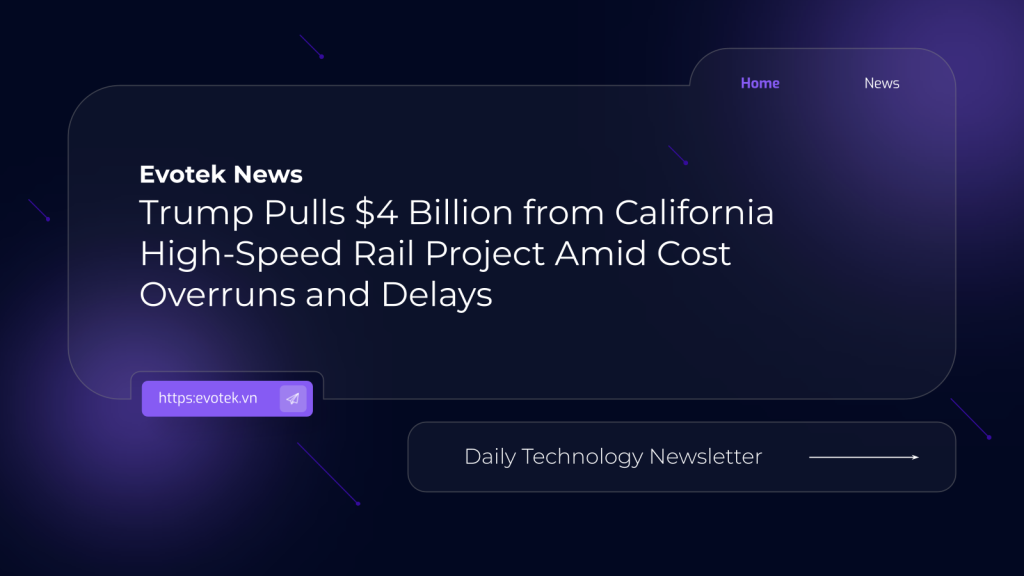In a significant move impacting California’s ambitious transportation future, U.S. President Donald Trump announced Wednesday that the Department of Transportation is officially rescinding $4 billion in federal funding earmarked for the state’s High-Speed Rail project.
President Trump articulated his strong disapproval of the initiative on social media, labeling the project as “severely overpriced, overregulated, and never delivered.” He asserted that the promised railroad “still does not exist and never will,” casting doubt on its ultimate completion. The Department of Transportation echoed the President’s sentiments, stating there was “no viable path forward” for the project and even hinting at attempts to “claw back” additional related funding, citing its “grossly over budget” status.
California officials swiftly condemned the decision, deeming it an “illegal action.” This latest development intensifies the ongoing political friction between President Trump’s administration and California, a state with which he has frequently clashed over various policy matters, including environmental regulations, social issues, and now, critical infrastructure.
Governor Gavin Newsom released a statement asserting, “California is putting all options on the table to fight this illegal action,” signaling a potential legal battle to reclaim the vital funding.
Federal Concerns Over Project Viability
The federal decision follows a critical 315-page report from the Federal Railroad Administration (FRA) issued last month. This extensive report highlighted numerous issues, including consistent missed deadlines, significant budget shortfalls, and questionable projections for future ridership. Specifically, the FRA noted that California had yet to secure an additional $7 billion required to complete an initial 171-mile segment between Merced and Bakersfield, and importantly, track laying has yet to commence.
Project Ambitions and Soaring Costs
The California High-Speed Rail System, envisioned as an 800-mile (1,287 km) two-phase network, aims to connect major metropolitan areas like San Francisco, Los Angeles, and Anaheim, with future extensions to Sacramento and San Diego, reaching speeds of up to 220 miles per hour. This monumental undertaking, initially projected for completion by 2020 at a cost of $33 billion for the San Francisco-to-Los Angeles route, has seen its estimated expenses skyrocket from $89 billion to an alarming $128 billion.
Ian Choudri, CEO of the California High-Speed Rail Authority, vehemently stated, “Canceling these grants without cause isn’t just wrong — it’s illegal.” Choudri underscored that the agreements were “legally binding” and affirmed that the Authority had met “every obligation,” arguing that this was “no time for Washington to walk away on America’s transportation future.” The Authority further defended its progress, highlighting that the project is “fast approaching the track-laying phase,” with 171 miles currently under active construction and design, responsible for creating 15,500 jobs, and completing over 50 major structures.
Despite the federal setback, Governor Newsom continues to advocate for the project, with a budget proposal currently before the legislature that seeks to allocate at least $1 billion annually for the next two decades. This funding is intended to provide the “necessary resources to complete the project’s initial operating segment.”
Political Sparring and Funding History
The dispute also spilled onto social media, with Transportation Secretary Sean Duffy posting on Platform X that “Newsom and California’s high-speed rail boondoggle are the definition of government incompetence and possibly corruption.” Governor Newsom swiftly retorted, quipping, “Won’t be taking advice from the guy who can’t keep planes in the sky,” in a clear jab at the Secretary.
The California High-Speed Rail initiative secured an initial $10 billion through voter approval in 2008. Notably, former President Joe Biden’s administration had previously awarded approximately $4 billion to the project. This isn’t the first time federal funding has been a point of contention; in 2021, the Biden administration reinstated a $929 million grant that President Trump had revoked in 2019, following a successful lawsuit by the state after Trump had famously called the project a “disaster.”
This latest withdrawal of funds marks a critical juncture for California’s high-speed rail ambitions, intensifying the political and legal battles surrounding one of the nation’s most ambitious and controversial infrastructure projects.

 日本語
日本語 한국어
한국어 Tiếng Việt
Tiếng Việt 简体中文
简体中文